Indoor Air Quality at an Urban Primary School in Madrid (Spain): Influence of Surrounding Environment and Occupancy
Abstract
:1. Introduction
1.1. Experimental Site and Measurements
1.2. Data Analysis
2. Results and Discussion
2.1. Overview: Meteorology and Local Air Quality
2.2. Outdoor Air Pollutants in the School’s Surroundings
2.3. Indoor Air Quality and Impact of Outdoor Air by Infiltration
2.4. Effects of Occupancy on the Indoor Air Quality
3. Conclusions
Supplementary Materials
Author Contributions
Funding
Institutional Review Board Statement
Data Availability Statement
Conflicts of Interest
References
- Mayer, H. Air pollution in cities. Atmos. Environ. 1999, 33, 4029–4037. [Google Scholar] [CrossRef]
- Curtis, L.; Rea, W.; Smith-Willis, P.; Fenyves, E.; Pan, Y. Adverse health effects of outdoor air pollutants. Environ. Int. 2006, 32, 815–830. [Google Scholar] [CrossRef]
- Mannucci, P.M.; Harari, S.; Martinelli, I.; Franchini, M. Effects on health of air pollution: A narrative review. Intern. Emerg. Med. 2015, 10, 657–662. [Google Scholar] [CrossRef]
- WHO. WHO Global Air Quality Guidelines: Particulate Matter (PM2.5 and PM10), Ozone, Nitrogen Dioxide, Sulfur Dioxide and Carbon Monoxide; WHO: Geneva, Switzerland, 2021.
- Leung, D.Y. Outdoor-indoor air pollution in urban environment: Challenges and opportunity. Front. Environ. Sci. 2015, 2, 69. [Google Scholar] [CrossRef]
- Faustman, E.M.; Silbernagel, S.M.; Fenske, R.A.; Burbacher, T.M.; Ponce, R.A. Mechanisms underlying Children’s susceptibility to environmental toxicants. Environ. Health Perspect. 2000, 108, 13–21. [Google Scholar]
- Makri, A.; Stilianakis, N.I. Vulnerability to air pollution health effects. Int. J. Hyg. Environ. Health 2008, 211, 326–336. [Google Scholar] [CrossRef]
- WHO. Air Pollution and Child Health: Prescribing Clean Air; World Health Organization: Geneva, Switzerland, 2018.
- Garcia, E.; Rice, M.B.; Gold, D.R. Air pollution and lung function in children. J. Allergy Clin. Immunol. 2021, 148, 1–14. [Google Scholar] [CrossRef]
- Matthaios, V.N.; Kang, C.-M.; Wolfson, J.M.; Greco, K.F.; Gaffin, J.M.; Hauptman, M.; Cunningham, A.; Petty, C.R.; Lawrence, J.; Phipatanakul, W. Factors influencing classroom exposures to fine particles, black carbon, and nitrogen dioxide in inner-city schools and their implications for indoor air quality. Environ. Health Perspect. 2022, 130, 47005. [Google Scholar] [CrossRef]
- Bateson, T.F.; Schwartz, J. Children’s response to air pollutants. J. Toxicol. Environ. Health Part A 2007, 71, 238–243. [Google Scholar] [CrossRef] [PubMed]
- de Gennaro, G.; Dambruoso, P.R.; Loiotile, A.D.; Di Gilio, A.; Giungato, P.; Tutino, M.; Marzocca, A.; Mazzone, A.; Palmisani, J.; Porcelli, F. Indoor air quality in schools. Environ. Chem. Lett. 2014, 12, 467–482. [Google Scholar] [CrossRef]
- Fsadni, P.; Bezzina, F.; Fsadni, C.; Montefort, S. Impact of school air quality on children’s respiratory health. Indian J. Occup. Environ. Med. 2018, 22, 156. [Google Scholar] [CrossRef]
- Madureira, J.; Paciência, I.; Rufo, J.; Ramos, E.; Barros, H.; Teixeira, J.P.; de Oliveira Fernandes, E. Indoor air quality in schools and its relationship with children’s respiratory symptoms. Atmos. Environ. 2015, 118, 145–156. [Google Scholar] [CrossRef]
- Pacitto, A.; Stabile, L.; Viana, M.; Scungio, M.; Reche, C.; Querol, X.; Alastuey, A.; Rivas, I.; Álvarez-Pedrerol, M.; Sunyer, J. Particle-related exposure, dose and lung cancer risk of primary school children in two European countries. Sci. Total Environ. 2018, 616, 720–729. [Google Scholar] [CrossRef] [PubMed]
- Zainudin, M.A.; Jalaludin, J.; Sopian, N.A. Indoor Air Quality (IAQ) in Preschools and Its Association with Respiratory Inflammation among Pre-schoolers. Malays. J. Med. Health Sci. 2019, 15, 12–18. [Google Scholar]
- Annesi-Maesano, I.; Hulin, M.; Lavaud, F.; Raherison, C.; Kopferschmitt, C.; de Blay, F.; Charpin, D.A.; Denis, C. Poor air quality in classrooms related to asthma and rhinitis in primary schoolchildren of the French 6 Cities Study. Thorax 2012, 67, 682–688. [Google Scholar] [CrossRef]
- Szabados, M.; Kakucs, R.; Páldy, A.; Kotlík, B.; Kazmarová, H.; Dongiovanni, A.; Di Maggio, A.; Kozajda, A.; Jutraz, A.; Kukec, A. Association of parent-reported health symptoms with indoor air quality in primary school buildings–the InAirQ study. Build. Environ. 2022, 221, 109339. [Google Scholar] [CrossRef]
- Isa, K.N.M.; Hashim, Z.; Jalaludin, J.; Norbäck, D.; Jabbar, M.A.; Hashim, J.H. The impact of exposure to indoor pollutants on allergy and lung inflammation among school children in Selangor, Malaysia: An evaluation using factor analysis. Aerosol Air Qual. Res. 2020, 20, 2371–2383. [Google Scholar]
- Salthammer, T.; Uhde, E.; Schripp, T.; Schieweck, A.; Morawska, L.; Mazaheri, M.; Clifford, S.; He, C.; Buonanno, G.; Querol, X. Children’s well-being at schools: Impact of climatic conditions and air pollution. Environ. Int. 2016, 94, 196–210. [Google Scholar] [CrossRef]
- Annesi-Maesano, I.; Baiz, N.; Banerjee, S.; Rudnai, P.; Rive, S.; Group, S. Indoor air quality and sources in schools and related health effects. J. Toxicol. Environ. Health Part B 2013, 16, 491–550. [Google Scholar] [CrossRef]
- Kabirikopaei, A.; Lau, J.; Nord, J.; Bovaird, J. Identifying the K-12 classrooms’ indoor air quality factors that affect student academic performance. Sci. Total Environ. 2021, 786, 147498. [Google Scholar] [CrossRef] [PubMed]
- Wargocki, P.; Porras-Salazar, J.A.; Contreras-Espinoza, S.; Bahnfleth, W. The relationships between classroom air quality and children’s performance in school. Build. Environ. 2020, 173, 106749. [Google Scholar] [CrossRef]
- Wargocki, P. Effects of classroom air quality on learning in schools. In Handbook of Indoor Air Quality; Springer: Berlin, Germany, 2022; pp. 1447–1459. [Google Scholar]
- Sunyer, J.; Esnaola, M.; Alvarez-Pedrerol, M.; Forns, J.; Rivas, I.; López-Vicente, M.; Suades-González, E.; Foraster, M.; Garcia-Esteban, R.; Basagaña, X. Association between traffic-related air pollution in schools and cognitive development in primary school children: A prospective cohort study. PLoS Med. 2015, 12, e1001792. [Google Scholar] [CrossRef]
- Wang, S.; Zhang, J.; Zeng, X.; Zeng, Y.; Wang, S.; Chen, S. Association of traffic-related air pollution with children’s neurobehavioral functions in Quanzhou, China. Environ. Health Perspect. 2009, 117, 1612–1618. [Google Scholar] [CrossRef]
- Chithra, V.; Shiva, N.S. A review of scientific evidence on indoor air of school building: Pollutants, sources, health effects and management. Asian J. Atmos. Environ. 2018, 12, 87–108. [Google Scholar] [CrossRef]
- Pallarés, S.; Gómez, E.; Martínez, A.; Jordán, M.M. The relationship between indoor and outdoor levels of PM10 and its chemical composition at schools in a coastal region in Spain. Heliyon 2019, 5, e02270. [Google Scholar] [CrossRef]
- Reche, C.; Rivas, I.; Pandolfi, M.; Viana, M.; Bouso, L.; Àlvarez-Pedrerol, M.; Alastuey, A.; Sunyer, J.; Querol, X. Real-time indoor and outdoor measurements of black carbon at primary schools. Atmos. Environ. 2015, 120, 417–426. [Google Scholar] [CrossRef]
- Faria, T.; Martins, V.; Correia, C.; Canha, N.; Diapouli, E.; Manousakas, M.; Eleftheriadis, K.; Almeida, S. Children’s exposure and dose assessment to particulate matter in Lisbon. Build. Environ. 2020, 171, 106666. [Google Scholar] [CrossRef]
- Bennett, J.; Davy, P.; Trompetter, B.; Wang, Y.; Pierse, N.; Boulic, M.; Phipps, R.; Howden-Chapman, P. Sources of indoor air pollution at a New Zealand urban primary school; a case study. Atmos. Pollut. Res. 2019, 10, 435–444. [Google Scholar] [CrossRef]
- Li, K.; Shen, J.; Zhang, X.; Chen, L.; White, S.; Yan, M.; Han, L.; Yang, W.; Wang, X.; Azzi, M. Variations and characteristics of particulate matter, black carbon and volatile organic compounds in primary school classrooms. J. Clean. Prod. 2020, 252, 119804. [Google Scholar] [CrossRef]
- Poupard, O.; Blondeau, P.; Iordache, V.; Allard, F. Statistical analysis of parameters influencing the relationship between outdoor and indoor air quality in schools. Atmos. Environ. 2005, 39, 2071–2080. [Google Scholar] [CrossRef]
- Stranger, M.; Potgieter-Vermaak, S.; Van, R.G. Characterization of indoor air quality in primary schools in Antwerp, Belgium. Indoor Air 2008, 18, 454–463. [Google Scholar] [CrossRef] [PubMed]
- Kumar, P.; Omidvarborna, H.; Pilla, F.; Lewin, N. A primary school driven initiative to influence commuting style for dropping-off and picking-up of pupils. Sci. Total Environ. 2020, 727, 138360. [Google Scholar] [CrossRef] [PubMed]
- Morawska, L.; Ayoko, G.; Bae, G.; Buonanno, G.; Chao, C.; Clifford, S.; Fu, S.C.; Hänninen, O.; He, C.; Isaxon, C. Airborne particles in indoor environment of homes, schools, offices and aged care facilities: The main routes of exposure. Environ. Int. 2017, 108, 75–83. [Google Scholar] [CrossRef]
- Chan, A.T. Indoor–outdoor relationships of particulate matter and nitrogen oxides under different outdoor meteorological conditions. Atmos. Environ. 2002, 36, 1543–1551. [Google Scholar] [CrossRef]
- Janssen, N.A.; van Vliet, P.H.; Aarts, F.; Harssema, H.; Brunekreef, B. Assessment of exposure to traffic related air pollution of children attending schools near motorways. Atmos. Environ. 2001, 35, 3875–3884. [Google Scholar] [CrossRef]
- Krugly, E.; Martuzevicius, D.; Sidaraviciute, R.; Ciuzas, D.; Prasauskas, T.; Kauneliene, V.; Stasiulaitiene, I.; Kliucininkas, L. Characterization of particulate and vapor phase polycyclic aromatic hydrocarbons in indoor and outdoor air of primary schools. Atmos. Environ. 2014, 82, 298–306. [Google Scholar] [CrossRef]
- Rivas, I.; Viana, M.; Moreno, T.; Pandolfi, M.; Amato, F.; Reche, C.; Bouso, L.; Àlvarez-Pedrerol, M.; Alastuey, A.; Sunyer, J. Child exposure to indoor and outdoor air pollutants in schools in Barcelona, Spain. Environ. Int. 2014, 69, 200–212. [Google Scholar] [CrossRef]
- Tran, D.T.; Alleman, L.Y.; Coddeville, P.; Galloo, J.-C. Elemental characterization and source identification of size resolved atmospheric particles in French classrooms. Atmos. Environ. 2012, 54, 250–259. [Google Scholar] [CrossRef]
- Chithra, V.; Nagendra, S.S. Impact of outdoor meteorology on indoor PM10, PM2.5 and PM1 concentrations in a naturally ventilated classroom. Urban Clim. 2014, 10, 77–91. [Google Scholar] [CrossRef]
- Elbayoumi, M.; Ramli, N.A.; Yusof, N.F.F.M. Spatial and temporal variations in particulate matter concentrations in twelve schools environment in urban and overpopulated camps landscape. Build. Environ. 2015, 90, 157–167. [Google Scholar] [CrossRef]
- Majd, E.; McCormack, M.; Davis, M.; Curriero, F.; Berman, J.; Connolly, F.; Leaf, P.; Rule, A.; Green, T.; Clemons-Erby, D. Indoor air quality in inner-city schools and its associations with building characteristics and environmental factors. Environ. Res. 2019, 170, 83–91. [Google Scholar] [CrossRef] [PubMed]
- Xu, R.; Qi, X.; Dai, G.; Lin, H.; Zhai, P.; Zhu, C.; Wang, L.; Ding, A. A Comparison Study of Indoor and Outdoor Air Quality in Nanjing, China. Aerosol Air Qual. Res. 2020, 20, 2128–2141. [Google Scholar] [CrossRef]
- Hu, Y.-J.; Bao, L.-J.; Huang, C.-L.; Li, S.-M.; Liu, P.; Zeng, E.Y. Exposure to air particulate matter with a case study in Guangzhou: Is indoor environment a safe haven in China? Atmos. Environ. 2018, 191, 351–359. [Google Scholar] [CrossRef]
- Tippayawong, N.; Khuntong, P. Model prediction of indoor particle concentrations in a public school classroom. J. Chin. Inst. Eng. 2007, 30, 1077–1083. [Google Scholar] [CrossRef]
- Canha, N.; Martinho, M.; Almeida-Silva, M.; Freitas, M.d.C.; Almeida, S.M.; Pegas, P.; Alves, C.; Pio, C.; Trancoso, M.A.; Sousa, R. Indoor air quality in primary schools. Int. J. Environ. Pollut. 2012, 50, 396–410. [Google Scholar] [CrossRef]
- Moreno, T.; Rivas, I.; Bouso, L.; Viana, M.; Jones, T.; Àlvarez-Pedrerol, M.; Alastuey, A.; Sunyer, J.; Querol, X. Variations in school playground and classroom atmospheric particulate chemistry. Atmos. Environ. 2014, 91, 162–171. [Google Scholar] [CrossRef]
- Pegas, P.; Nunes, T.; Alves, C.; Silva, J.; Vieira, S.; Caseiro, A.; Pio, C. Indoor and outdoor characterisation of organic and inorganic compounds in city centre and suburban elementary schools of Aveiro, Portugal. Atmos. Environ. 2012, 55, 80–89. [Google Scholar] [CrossRef]
- Lin, C.-C.; Lee, M.-K.; Huang, H.-L. Effects of chalk use on dust exposure and classroom air quality. Aerosol Air Qual. Res. 2015, 15, 2596–2608. [Google Scholar] [CrossRef]
- Ma, C.-J.; Kang, G.-U.; Hamada, M. Behavior and Exposure of Chalk Dust during Classroom Teaching. Asian J. Atmos. Environ. 2019, 13, 240–248. [Google Scholar] [CrossRef]
- Qian, J.; Peccia, J.; Ferro, A.R. Walking-induced particle resuspension in indoor environments. Atmos. Environ. 2014, 89, 464–481. [Google Scholar] [CrossRef]
- Yuhe, Z.; Guangfei, Y.; Xianneng, L. Indoor PM2.5 concentrations and students’ behavior in primary school classrooms. J. Clean. Prod. 2021, 318, 128460. [Google Scholar] [CrossRef]
- Tham, K.W. Indoor air quality and its effects on humans—A review of challenges and developments in the last 30 years. Energy Build. 2016, 130, 637–650. [Google Scholar] [CrossRef]
- Ielpo, P.; Mangia, C.; de Gennaro, G.; Di Gilio, A.; Palmisani, J.; Dinoi, A.; Bergomi, A.; Comite, V.; Fermo, P. Air Quality Assessment of a School in an Industrialized Area of Southern Italy. Appl. Sci. 2021, 11, 8870. [Google Scholar] [CrossRef]
- Yang, W.; Sohn, J.; Kim, J.; Son, B.; Park, J. Indoor air quality investigation according to age of the school buildings in Korea. J. Environ. Manag. 2009, 90, 348–354. [Google Scholar] [CrossRef] [PubMed]
- Abdel-Salam, M.M. Investigation of indoor air quality at urban schools in Qatar. Indoor Built Environ. 2019, 28, 278–288. [Google Scholar] [CrossRef]
- Chithra, V.; Nagendra, S.S. Indoor air quality investigations in a naturally ventilated school building located close to an urban roadway in Chennai, India. Build. Environ. 2012, 54, 159–167. [Google Scholar] [CrossRef]
- Martins, V.; Faria, T.; Diapouli, E.; Manousakas, M.I.; Eleftheriadis, K.; Viana, M.; Almeida, S.M. Relationship between indoor and outdoor size-fractionated particulate matter in urban microenvironments: Levels, chemical composition and sources. Environ. Res. 2020, 183, 109203. [Google Scholar] [CrossRef]
- Tran, D.T.; Alleman, L.Y.; Coddeville, P.; Galloo, J.-C. Indoor–outdoor behavior and sources of size-resolved airborne particles in French classrooms. Build. Environ. 2014, 81, 183–191. [Google Scholar] [CrossRef]
- Artíñano, B.; Gómez-Moreno, F.J.; Alonso-Blanco, E.; Díaz, E.; Barreiro, M.; Fernandez, A.J.; Rubio, A.; Fernández, J.; Figuero, I.; Reinares, J.M.; et al. Air quality study in three scholar environments in Madrid. In Proceedings of the 6th Iberian Meeting on Aerosol Science and Technology (RICTA2018), Bilbao, Spain, 18–20 June 2018. [Google Scholar]
- Artíñano, B.; Gómez-Moreno, F.J.; Díaz, E.; Alonso-Blanco, E.; Barreiro, M.; Fernandez, A.; Rubio, A.; Fernández, J.; Figuero, I. Air quality monitoring in scholar environments. In Proceedings of the 2019 5th Experiment International Conference (exp. at’19), Funchal, Portugal, 12–14 June 2019; pp. 439–443. [Google Scholar]
- Comunidad de Madrid. Inventario de Emisiones a la Atmósfera en la Comunidad de Madrid 1990–2018. Available online: https://www.comunidad.madrid/sites/default/files/doc/medio-ambiente/documento_de_sintesis_inventario_de_emisiones_comunidad_de_madrid.pdf (accessed on 6 February 2024).
- Fernández García, F.; Allende Álvarez, F.; Rasilla Álvarez, D.; Martilli, A.; Alcaide Muñoz, J. Estudio de Detalle Del Clima Urbano de MADRID; Environment and Mobility Government Area, Madrid City Council: Madrid, Spain, 2016. [Google Scholar]
- Gómez-Moreno, F.; Pujadas, M.; Plaza, J.; Rodríguez-Maroto, J.; Martínez-Lozano, P.; Artíñano, B. Influence of seasonal factors on the atmospheric particle number concentration and size distribution in Madrid. Atmos. Environ. 2011, 45, 3169–3180. [Google Scholar] [CrossRef]
- Díaz, J.; García, R.; Ribera, P.; Alberdi, J.; Hernández, E.; Pajares, M.; Otero, A. Modeling of air pollution and its relationship with mortality and morbidity in Madrid, Spain. Int. Arch. Occup. Environ. Health 1999, 72, 366–376. [Google Scholar] [CrossRef]
- Crespí, S.N.; Artíñano, B.; Cabal, H. Synoptic classification of the mixed-layer height evolution. J. Appl. Meteorol. 1995, 34, 1666–1677. [Google Scholar] [CrossRef]
- Salvador, P.; Artíñano, B.; Molero, F.; Viana, M.; Pey, J.; Alastuey, A.; Querol, X. African dust contribution to ambient aerosol levels across central Spain: Characterization of long-range transport episodes of desert dust. Atmos. Res. 2013, 127, 117–129. [Google Scholar] [CrossRef]
- Alastuey, A.; Querol, X.; Castillo, S.; Escudero, M.; Avila, A.; Cuevas, E.; Torres, C.; Romero, P.-M.; Exposito, F.; García, O. Characterisation of TSP and PM2.5 at Izaña and Sta. Cruz de Tenerife (Canary Islands, Spain) during a Saharan Dust Episode (July 2002). Atmos. Environ. 2005, 39, 4715–4728. [Google Scholar] [CrossRef]
- Pandolfi, M.; Tobias, A.; Alastuey, A.; Sunyer, J.; Schwartz, J.; Lorente, J.; Pey, J.; Querol, X. Effect of atmospheric mixing layer depth variations on urban air quality and daily mortality during Saharan dust outbreaks. Sci. Total Environ. 2014, 494, 283–289. [Google Scholar] [CrossRef]
- Salas, R.; Perez-Villadoniga, M.J.; Prieto-Rodriguez, J.; Russo, A. Were traffic restrictions in Madrid effective at reducing NO2 levels? Transp. Res. Part D Transp. Environ. 2021, 91, 102689. [Google Scholar] [CrossRef]
- Borge, R.; Santiago, J.L.; de la Paz, D.; Martín, F.; Domingo, J.; Valdés, C.; Sánchez, B.; Rivas, E.; Rozas, M.T.; Lázaro, S. Application of a short term air quality action plan in Madrid (Spain) under a high-pollution episode-Part II: Assessment from multi-scale modelling. Sci. Total Environ. 2018, 635, 1574–1584. [Google Scholar] [CrossRef]
- Borge, R.; Artíñano, B.; Yagüe, C.; Gomez-Moreno, F.J.; Saiz-Lopez, A.; Sastre, M.; Narros, A.; García-Nieto, D.; Benavent, N.; Maqueda, G. Application of a short term air quality action plan in Madrid (Spain) under a high-pollution episode-Part I: Diagnostic and analysis from observations. Sci. Total Environ. 2018, 635, 1561–1573. [Google Scholar] [CrossRef]
- Petzold, A.; Ogren, J.A.; Fiebig, M.; Laj, P.; Li, S.-M.; Baltensperger, U.; Holzer-Popp, T.; Kinne, S.; Pappalardo, G.; Sugimoto, N. Recommendations for reporting “black carbon” measurements. Atmos. Chem. Phys. 2013, 13, 8365–8379. [Google Scholar] [CrossRef]
- Gómez-Moreno, F.J.; Alonso, E.; Artíñano, B.; Rodríguez-Maroto, J.; Rojas, E.; Piñeiro-Iglesias, M.; López-Mahía, P.; Pérez, N.; Alastuey, A.; Archilla, V.; et al. An intercomparison campaign for CPC, SMPS and UFPM in the frame of the REDMAAS network. In Proceedings of the 4th Iberian Meeting on Aerosol Science and Technology: Proceedings Book RICTA 2016, Aveiro, Portugal, 29 June–1 July 2016. [Google Scholar]
- Cuesta-Mosquera, A.; Močnik, G.; Drinovec, L.; Müller, T.; Pfeifer, S.; Minguillón, M.C.; Briel, B.; Buckley, P.; Dudoitis, V.; Fernández-García, J. Intercomparison and characterization of 23 Aethalometers under laboratory and ambient air conditions: Procedures and unit-to-unit variabilities. Atmos. Meas. Tech. 2021, 14, 3195–3216. [Google Scholar] [CrossRef]
- Barreiro, M.; Alonso-Blanco, E.; Marta, B.; Esther, C.; Elías, D.; J, F.A.; Gómez-Moreno, F.J.; Francisco, M.; Lourdes, N.; Magdalena, P.; et al. Continuous observations of chemical and physical properties of atmospheric aerosols in southern Europe. In Proceedings of the International Conference on Aerosol Cycle Sources-Aging-Sinks-Impact (ICAC 2017), Lille, France, 21–23 March 2017; p. 77. [Google Scholar]
- Council, M.C. Madrid 2023 Annual Air Quality Assessment Report. General Directorate of Sustainability and Environmental Control. Available online: https://airedemadrid.madrid.es/UnidadesDescentralizadas/Sostenibilidad/CalidadAire/Publicaciones/Memorias_anuales/Ficheros/Resumen_calidad_aire_2023.pdf (accessed on 6 February 2024).
- Salvador, P.; Barreiro, M.; Gómez-Moreno, F.J.; Alonso-Blanco, E.; Artíñano, B. Synoptic classification of meteorological patterns and their impact on air pollution episodes and new particle formation processes in a south European air basin. Atmos. Environ. 2020, 245, 118016. [Google Scholar] [CrossRef]
- Long, C.M.; Suh, H.H.; Catalano, P.J.; Koutrakis, P. Using time-and size-resolved particulate data to quantify indoor penetration and deposition behavior. Environ. Sci. Technol. 2001, 35, 2089–2099. [Google Scholar] [CrossRef] [PubMed]
- Portela, N.B.; Teixeira, E.C.; Agudelo-Castañeda, D.M.; da Silva Civeira, M.; Silva, L.F.O.; Vigo, A.; Kumar, P. Indoor-outdoor relationships of airborne nanoparticles, BC and VOCs at rural and urban preschools. Environ. Pollut. 2021, 268, 115751. [Google Scholar] [CrossRef] [PubMed]
- Buonanno, G.; Stabile, L.; Morawska, L.; Russi, A. Children exposure assessment to ultrafine particles and black carbon: The role of transport and cooking activities. Atmos. Environ. 2013, 79, 53–58. [Google Scholar] [CrossRef]
- Buonanno, G.; Fuoco, F.C.; Morawska, L.; Stabile, L. Airborne particle concentrations at schools measured at different spatial scales. Atmos. Environ. 2013, 67, 38–45. [Google Scholar] [CrossRef]
- Hassanvand, M.S.; Naddafi, K.; Faridi, S.; Arhami, M.; Nabizadeh, R.; Sowlat, M.H.; Pourpak, Z.; Rastkari, N.; Momeniha, F.; Kashani, H. Indoor/outdoor relationships of PM10, PM2.5, and PM1 mass concentrations and their water-soluble ions in a retirement home and a school dormitory. Atmos. Environ. 2014, 82, 375–382. [Google Scholar] [CrossRef]
- Viana, M.; Rivas, I.; Querol, X.; Alastuey, A.; Sunyer, J.; Álvarez-Pedrerol, M.; Bouso, L.; Sioutas, C. Indoor/outdoor relationships of quasi-ultrafine, accumulation and coarse mode particles in school environments in Barcelona: Chemical composition and sources. Atmos. Chem. Phys. 2013, 13, 32849–32883. [Google Scholar]
- MacNeill, M.; Wallace, L.; Kearney, J.; Allen, R.; Van Ryswyk, K.; Judek, S.; Xu, X.; Wheeler, A. Factors influencing variability in the infiltration of PM2.5 mass and its components. Atmos. Environ. 2012, 61, 518–532. [Google Scholar] [CrossRef]
- Kearney, J.; Wallace, L.; MacNeill, M.; Héroux, M.-E.; Kindzierski, W.; Wheeler, A. Residential infiltration of fine and ultrafine particles in Edmonton. Atmos. Environ. 2014, 94, 793–805. [Google Scholar] [CrossRef]
- Wan, Y.; Chen, C.; Wang, P.; Wang, Y.; Chen, Z.; Zhao, L. Infiltration characteristic of outdoor fine particulate matter (PM2.5) for the window gaps. Procedia Eng. 2015, 121, 191–198. [Google Scholar] [CrossRef]
- Lunden, M.M.; Kirchstetter, T.W.; Thatcher, T.L.; Hering, S.V.; Brown, N.J. Factors affecting the indoor concentrations of carbonaceous aerosols of outdoor origin. Atmos. Environ. 2008, 42, 5660–5671. [Google Scholar] [CrossRef]
- Shrestha, G.; Traina, S.J.; Swanston, C.W. Black carbon’s properties and role in the environment: A comprehensive review. Sustainability 2010, 2, 294–320. [Google Scholar] [CrossRef]
- Nazaroff, W.W. Indoor particle dynamics. Indoor Air 2004, 14, 175–183. [Google Scholar] [CrossRef] [PubMed]
- World Health Organization. Health Effects Of Black Carbon; WHO: Geneva, Switzerland, 2012.
- Bennett, W.D.; Zeman, K.L.; Jarabek, A.M. Nasal contribution to breathing and fine particle deposition in children versus adults. J. Toxicol. Environ. Health Part A 2008, 71, 227–237. [Google Scholar] [CrossRef] [PubMed]
- Zhu, Y.; Hinds, W.C.; Krudysz, M.; Kuhn, T.; Froines, J.; Sioutas, C. Penetration of freeway ultrafine particles into indoor environments. J. Aerosol Sci. 2005, 36, 303–322. [Google Scholar] [CrossRef]
- Zwoździak, A.; Sówka, I.; Worobiec, A.; Zwoździak, J.; Nych, A. The contribution of outdoor particulate matter (PM1, PM2.5, PM10) to school indoor environment. Indoor Built Environ. 2015, 24, 1038–1047. [Google Scholar] [CrossRef]
- Artínano, B.; Salvador, P.; Alonso, D.; Querol, X.; Alastuey, A. Influence of traffic on the PM10 and PM2.5 urban aerosol fractions in Madrid (Spain). Sci. Total Environ. 2004, 334, 111–123. [Google Scholar] [CrossRef]
- Salvador, P.; Artíñano, B.; Alonso, D.G.; Querol, X.; Alastuey, A. Identification and characterisation of sources of PM10 in Madrid (Spain) by statistical methods. Atmos. Environ. 2004, 38, 435–447. [Google Scholar] [CrossRef]
- Cyrys, J.; Pitz, M.; Bischof, W.; Wichmann, H.E.; Heinrich, J. Relationship between indoor and outdoor levels of fine particle mass, particle number concentrations and black smoke under different ventilation conditions. J. Expo. Sci. Environ. Epidemiol. 2004, 14, 275–283. [Google Scholar] [CrossRef]
- Park, D.; Kang, K.; Na, H.; Lee, J.; Kim, S.; Kim, T. Measurement of Black Carbon Exposure in Urban Classrooms during Rush Hours. Atmos. Pollut. Res. 2024, 15, 102233. [Google Scholar] [CrossRef]
- Wichmann, J.; Lind, T.; Nilsson, M.-M.; Bellander, T. PM2.5, soot and NO.2 indoor–outdoor relationships at homes, pre-schools and schools in Stockholm, Sweden. Atmos. Environ. 2010, 44, 4536–4544. [Google Scholar] [CrossRef]
- Guo, H.; Morawska, L.; He, C.; Zhang, Y.L.; Ayoko, G.; Cao, M. Characterization of particle number concentrations and PM 2.5 in a school: Influence of outdoor air pollution on indoor air. Environ. Sci. Pollut. Res. 2010, 17, 1268–1278. [Google Scholar] [CrossRef] [PubMed]
- Chen, A.; Gall, E.T.; Chang, V.W. Indoor and outdoor particulate matter in primary school classrooms with fan-assisted natural ventilation in Singapore. Environ. Sci. Pollut. Res. 2016, 23, 17613–17624. [Google Scholar] [CrossRef] [PubMed]
- Parker, J.; Larson, R.; Eskelson, E.; Wood, E.; Veranth, J. Particle size distribution and composition in a mechanically ventilated school building during air pollution episodes. Indoor Air 2008, 18, 386–393. [Google Scholar] [CrossRef] [PubMed]
- Zhang, J.; Chen, J.; Yang, L.; Sui, X.; Yao, L.; Zheng, L.; Wen, L.; Xu, C.; Wang, W. Indoor PM2.5 and its chemical composition during a heavy haze–fog episode at Jinan, China. Atmos. Environ. 2014, 99, 641–649. [Google Scholar] [CrossRef]
- Alves, C.; Nunes, T.; Silva, J.; Duarte, M. Comfort parameters and particulate matter (PM10 and PM2.5) in school classrooms and outdoor air. Aerosol Air Qual. Res. 2013, 13, 1521–1535. [Google Scholar] [CrossRef]
- Dorizas, P.V.; Assimakopoulos, M.-N.; Helmis, C.; Santamouris, M. An integrated evaluation study of the ventilation rate, the exposure and the indoor air quality in naturally ventilated classrooms in the Mediterranean region during spring. Sci. Total Environ. 2015, 502, 557–570. [Google Scholar] [CrossRef]
- Nunes, R.; Branco, P.; Alvim-Ferraz, M.; Martins, F.; Sousa, S. Particulate matter in rural and urban nursery schools in Portugal. Environ. Pollut. 2015, 202, 7–16. [Google Scholar] [CrossRef]
- Tofful, L.; Perrino, C. Chemical composition of indoor and outdoor PM2.5 in three schools in the city of Rome. Atmos 2015, 6, 1422–1443. [Google Scholar] [CrossRef]
- U.S. EPA. National Ambient Air Quality Standards (NAAQS); The United States Environmental Protection Agency (EPA): Washington, DC, USA, 2006.
- Thatcher, T.L.; Layton, D.W. Deposition, resuspension, and penetration of particles within a residence. Atmos. Environ. 1995, 29, 1487–1497. [Google Scholar] [CrossRef]
- Becerra, J.A.; Lizana, J.; Gil, M.; Barrios-Padura, A.; Blondeau, P.; Chacartegui, R. Identification of potential indoor air pollutants in schools. J. Clean. Prod. 2020, 242, 118420. [Google Scholar] [CrossRef]
- van der Zee, S.C.; Strak, M.; Dijkema, M.B.; Brunekreef, B.; Janssen, N.A. The impact of particle filtration on indoor air quality in a classroom near a highway. Indoor Air 2017, 27, 291–302. [Google Scholar] [PubMed]
- Zhang, Q.; Zhu, Y. Characterizing ultrafine particles and other air pollutants at five schools in South Texas. Indoor Air 2012, 22, 33–42. [Google Scholar] [CrossRef] [PubMed]
- Stabile, L.; Dell’Isola, M.; Russi, A.; Massimo, A.; Buonanno, G. The effect of natural ventilation strategy on indoor air quality in schools. Sci. Total Environ. 2017, 595, 894–902. [Google Scholar] [CrossRef] [PubMed]
- Fuoco, F.C.; Stabile, L.; Buonanno, G.; Vargas Trassiera, C.; Massimo, A.; Russi, A.; Mazaheri, M.; Morawska, L.; Andrade, A. Indoor air quality in naturally ventilated Italian classrooms. Atmos 2015, 6, 1652–1675. [Google Scholar] [CrossRef]
- Baloch, R.M.; Maesano, C.N.; Christoffersen, J.; Banerjee, S.; Gabriel, M.; Csobod, É.; de Oliveira Fernandes, E.; Annesi-Maesano, I.; Szuppinger, P.; Prokai, R. Indoor air pollution, physical and comfort parameters related to schoolchildren’s health: Data from the European SINPHONIE study. Sci. Total Environ. 2020, 739, 139870. [Google Scholar] [CrossRef]
- Gómez-Moreno, F.J.; Alonso-Blanco, E.; Díaz, E.; Coz, E.; Molero, F.; Núñez, L.; Palacios, M.; Barreiro, M.; Fernández, J.; Salvador, P. On the influence of VOCs on new particle growth in a Continental-Mediterranean region. Environ. Res. Commun. 2022, 4, 125010. [Google Scholar] [CrossRef]
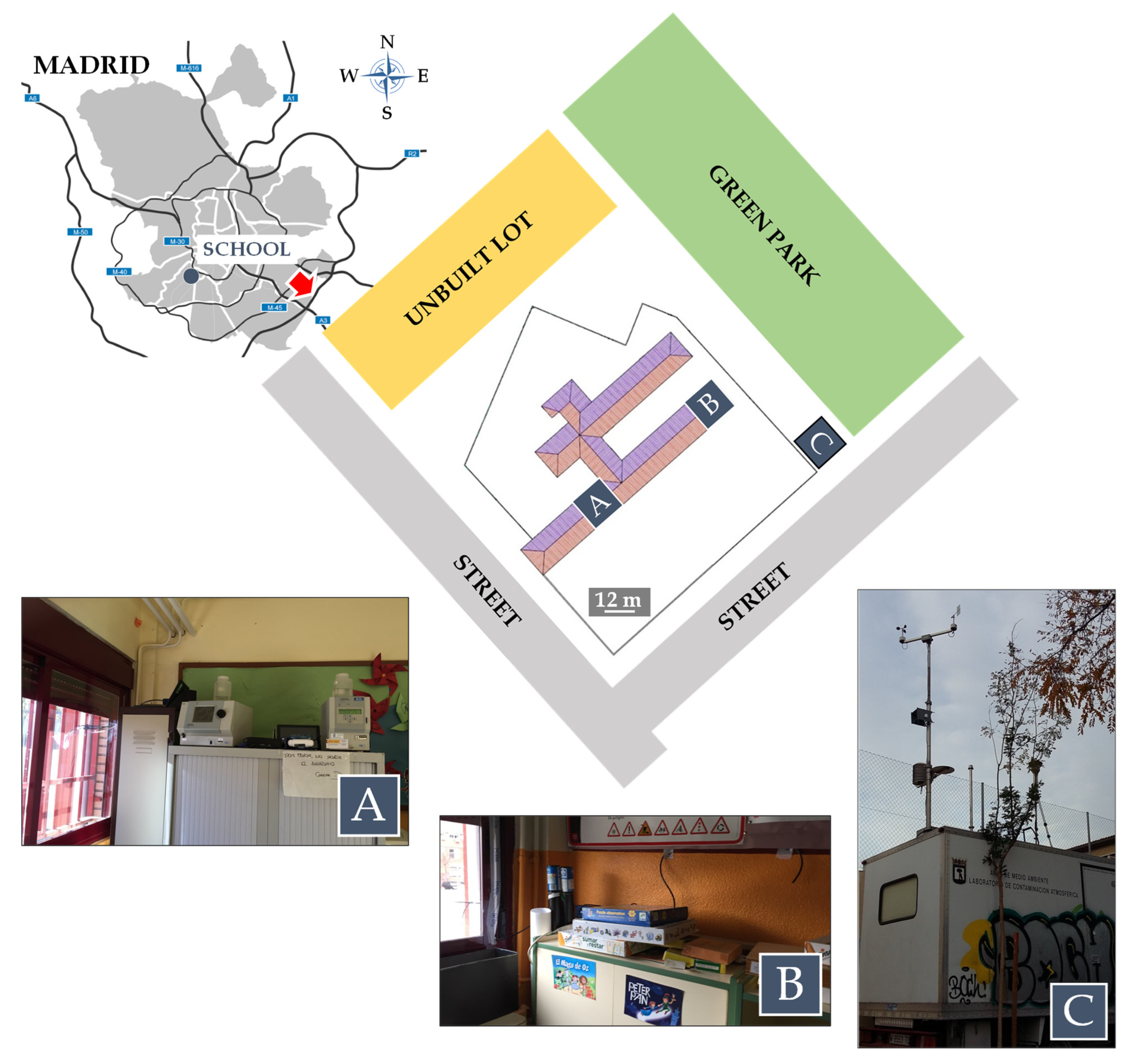
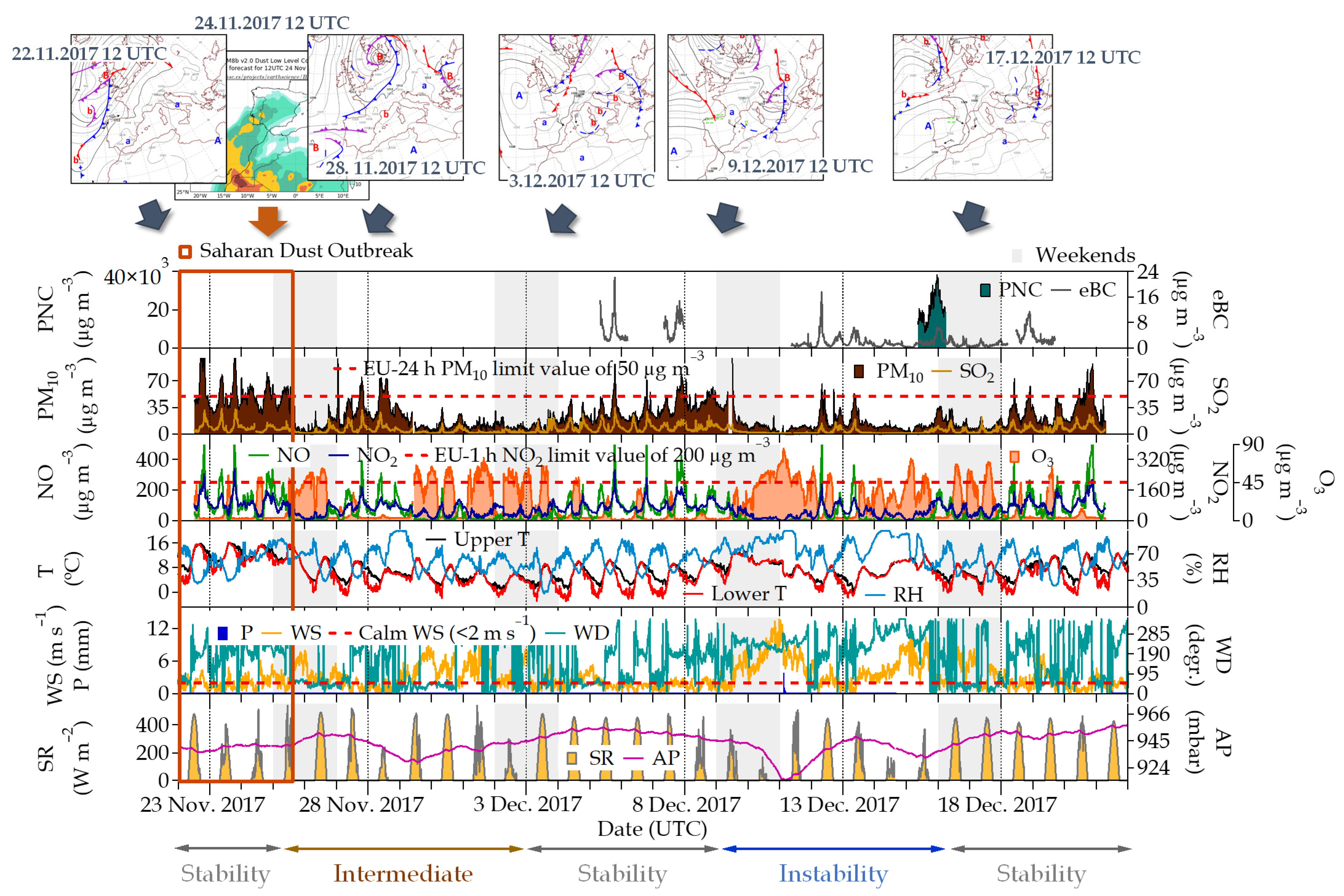
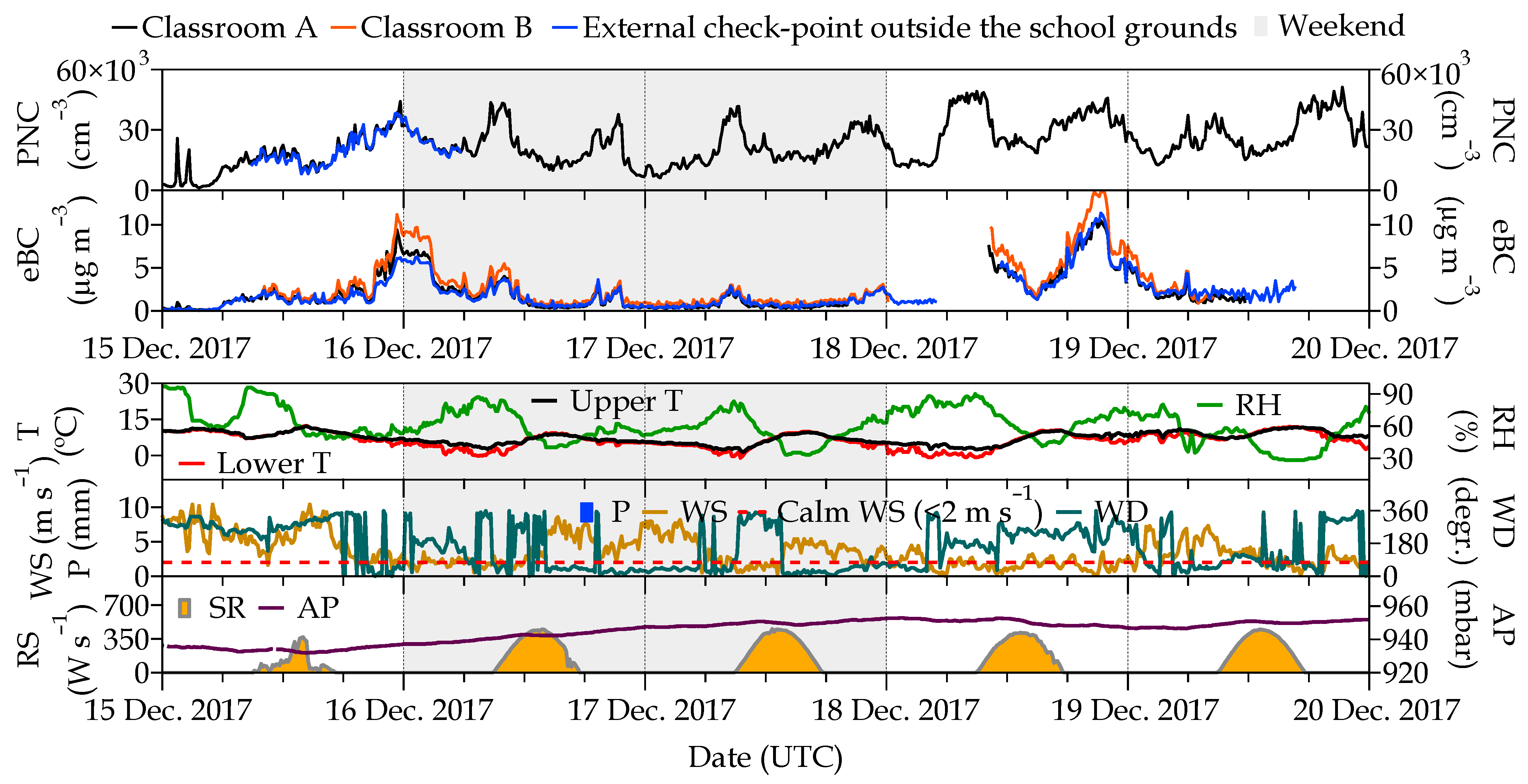
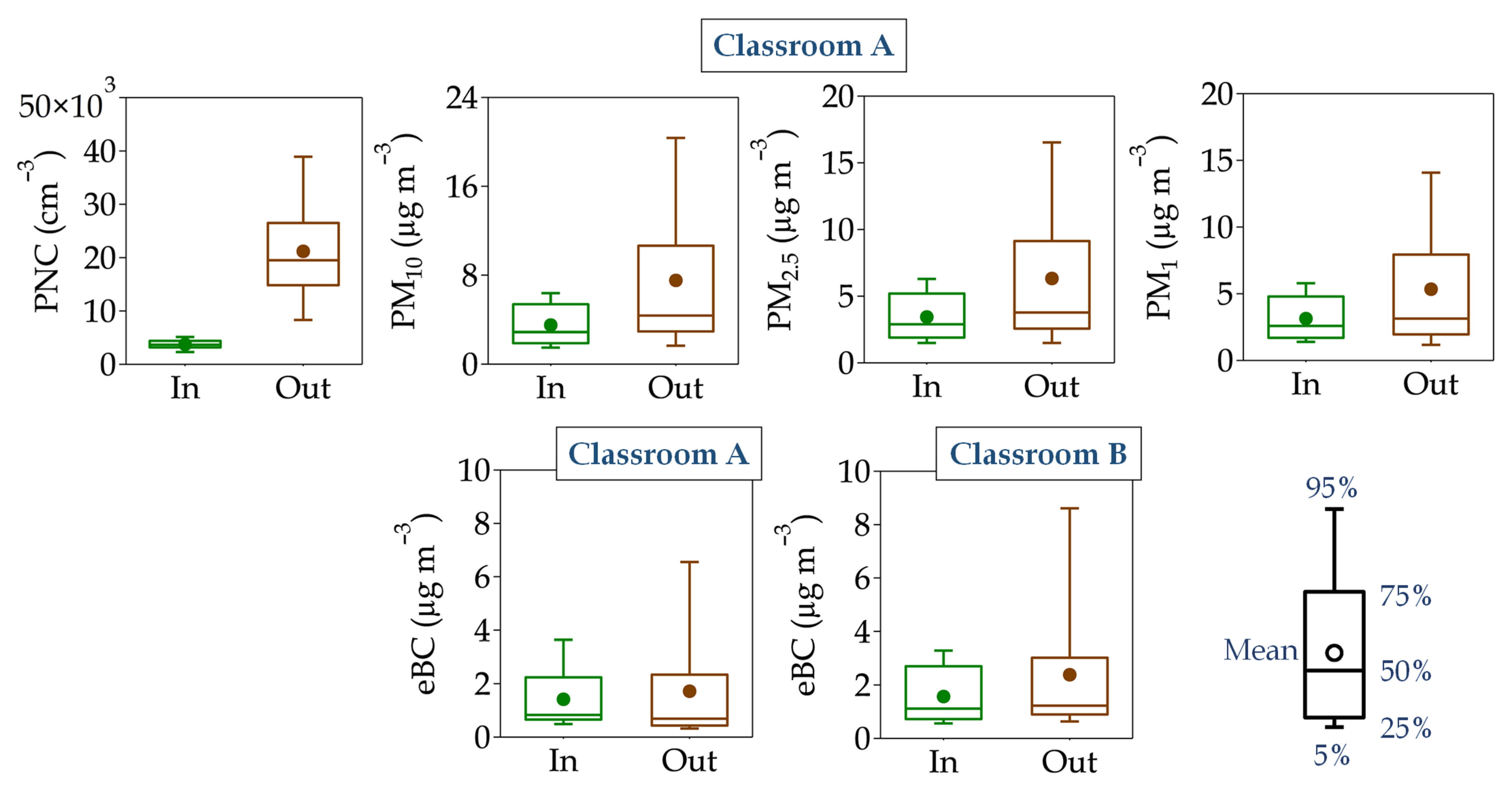
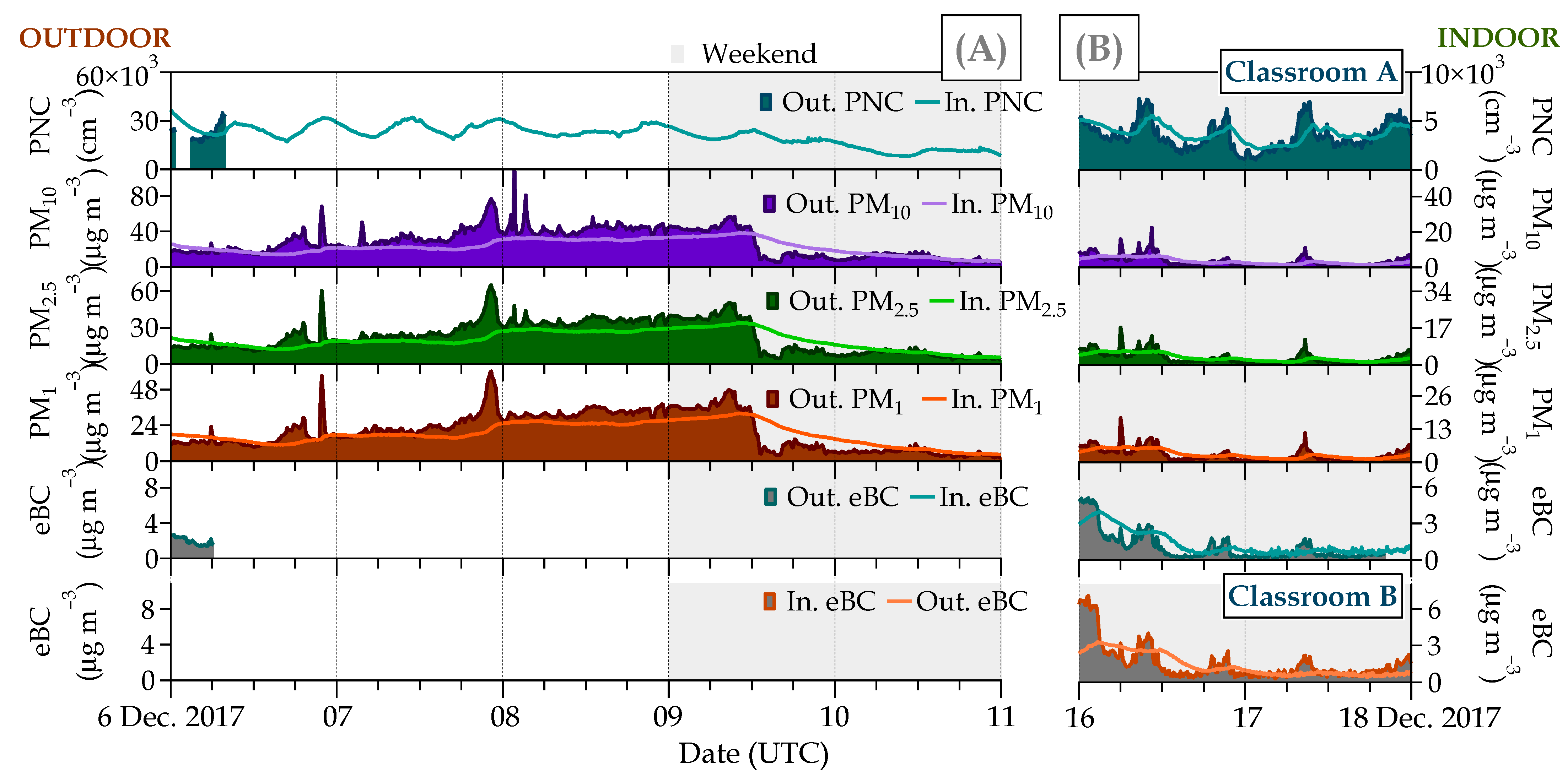

| Sampling Point | Instrument | Parameters | Measurement Size Range (µm) | Measurement Period |
|---|---|---|---|---|
| Classroom A | 2 MicroAeth® model AE51 (IN + OUT) | eBC | Total | 27 November–21 December 2017 |
| CPC, TSI model 3772 (IN) | PNC | >0.01 | 22 November–21 December 2017 | |
| CPC, TSI models 3775 and 3772-CEN (OUT) | >0.004 | |||
| 2 GRIMM Mini-Las 11-R (IN + OUT) | PM10, PM2.5, and PM1 obtained from counts | Mass concentration of particles <10, <2.5, and <1 µm, respectively | 5–21 December 2017 | |
| Classroom B | 2 MicroAeth® model AE51 (IN + OUT) | eBC | Total | 15–20 December 2017 |
| External check-point | MicroAeth® model AE51 (OUT) | eBC | Total | 5–20 December 2017 |
| CPC, TSI model 3775 (OUT) | PNC | >0.004 | 15–16 December 2017 | |
| Air quality measurements (OUT) | Trace gases (SO2, NO, NO2 and O3) and PM10 | - | 22 November–21 December 2017 | |
| CIEMAT site | Permanent meteorological tower | AP, T at two heights, RH, WS, WD | - | 22 November–21 December 2017 |
| Parameters | Mean | Night | Morning | Midday | Evening | |
|---|---|---|---|---|---|---|
| Atmospheric Stability Situation | ||||||
| WS (m s−1) | 1.3 | 1.2 | 1.1 | 1.5 | 1.6 | |
| Classroom A | ||||||
| I/O ratios | PNC | |||||
| PM10 | 0.4 | 0.5 | 0.4 | 0.4 | 0.3 | |
| PM2.5 | 0.5 | 0.6 | 0.5 | 0.5 | 0.4 | |
| PM1 | 0.5 | 0.7 | 0.6 | 0.5 | 0.4 | |
| eBC | ||||||
| Atmospheric Instability Situation | ||||||
| WS (m s−1) | 3.4 | 4.1 | 1.7 | 3.2 | 4.2 | |
| Classroom A | ||||||
| I/O ratios | PNC | 0.2 | 0.2 | 0.1 | 0.2 | 0.2 |
| PM10 | 0.6 | 0.6 | 0.4 | 0.9 | 0.5 | |
| PM2.5 | 0.7 | 0.6 | 0.4 | 1.1 | 0.5 | |
| PM1 | 0.7 | 0.8 | 0.5 | 1.2 | 0.6 | |
| eBC | 1.2 | 0.7 | 0.7 | 2.4 | 1.0 | |
| Classroom B | ||||||
| I/O ratios | eBC | 0.8 | 0.7 | 0.7 | 1.3 | 0.6 |
Disclaimer/Publisher’s Note: The statements, opinions and data contained in all publications are solely those of the individual author(s) and contributor(s) and not of MDPI and/or the editor(s). MDPI and/or the editor(s) disclaim responsibility for any injury to people or property resulting from any ideas, methods, instructions or products referred to in the content. |
© 2024 by the authors. Licensee MDPI, Basel, Switzerland. This article is an open access article distributed under the terms and conditions of the Creative Commons Attribution (CC BY) license (https://creativecommons.org/licenses/by/4.0/).
Share and Cite
Alonso-Blanco, E.; Gómez-Moreno, F.J.; Díaz-Ramiro, E.; Barreiro, M.; Fernández, J.; Figuero, I.; Rubio-Juan, A.; Santamaría, J.M.; Artíñano, B. Indoor Air Quality at an Urban Primary School in Madrid (Spain): Influence of Surrounding Environment and Occupancy. Int. J. Environ. Res. Public Health 2024, 21, 1263. https://doi.org/10.3390/ijerph21101263
Alonso-Blanco E, Gómez-Moreno FJ, Díaz-Ramiro E, Barreiro M, Fernández J, Figuero I, Rubio-Juan A, Santamaría JM, Artíñano B. Indoor Air Quality at an Urban Primary School in Madrid (Spain): Influence of Surrounding Environment and Occupancy. International Journal of Environmental Research and Public Health. 2024; 21(10):1263. https://doi.org/10.3390/ijerph21101263
Chicago/Turabian StyleAlonso-Blanco, Elisabeth, Francisco Javier Gómez-Moreno, Elías Díaz-Ramiro, Marcos Barreiro, Javier Fernández, Ibai Figuero, Alejandro Rubio-Juan, Jesús Miguel Santamaría, and Begoña Artíñano. 2024. "Indoor Air Quality at an Urban Primary School in Madrid (Spain): Influence of Surrounding Environment and Occupancy" International Journal of Environmental Research and Public Health 21, no. 10: 1263. https://doi.org/10.3390/ijerph21101263







